An Empowered Middle East – Part II
An Empowered Middle East – Part II
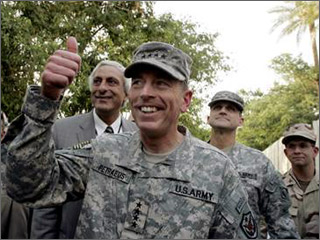
BAGHDAD: Iraq may have slipped as a priority in the American presidential campaign, as the military “surge,” or injection of extra troops ordered by President Bush mid-2007, begins to bring a fragile peace.
If the “surge” manages to end violence, with Iraq remaining a single nation, success is more likely to come from gritty deal-making with militia warlords than from America’s once-stated ideological mission of bringing democracy to Iraq and the wider Middle East. This new template will offer the next US administration a way forward in dealing with other failed states in the region and elsewhere.
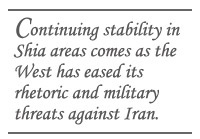
Apart from the US, the biggest external force in Iraq is Iran, whose military and political influence will remain for the foreseeable future. Its main sway is in the Shia-dominated south, and Britain’s withdrawal from the region ushers in a strategy to work with and not against Iran over the future of Iraq.
Washington doesn’t like discussing a direct link between Iran’s nuclear program and its influence in Iraq, yet continuing stability in Shia areas comes as the West has eased its rhetoric and military threats against Iran.
In May 2007, Ryan Crocker, US ambassador to Baghdad, met his Iranian diplomatic counterparts in the first face-to-face meeting between the two governments for almost 30 years. Crocker plans more talks in the near future, indicating that, despite recent gunboat video rhetoric, there’s a policy to build a long-term relationship over Iraq.
Iran is thought to be fully involved in brokering peace between the two main rival Shia groups, who in October 2007 fought pitched battles during a religious festival in the holy city of Kerbala.
The Supreme Iraqi Islamic Council led by the cleric Abdul Aziz al-Hakim is better organized politically, controls seven of the nine southern provincial governments and runs a militia known as the Badr Brigade. The Sadr group is led by the much younger cleric Muqtada al-Sadr, controls no provincial governments and draws support from the poorer sections of society. Its active militia, the Mehdi Army, has a reputation for ill-discipline and ruthlessness. Both militias have declared a ceasefire against coalition troops.
In the Sunni community, power lies more with tribal leaders than religious clerics. A generation ago, before Saddam Hussein’s wrecking, these Sunni leaders were at the forefront of building a modern Middle Eastern nation, with roads, hospitals and universities to match and women appointed to significant jobs.
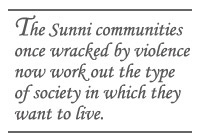
The brutality seen in the early years of the insurgency, from 2004 to 2006, came from the Sunni trauma of post-invasion paralysis, exploited and encouraged by Al Qaeda insurgents from outside. Al Qaeda assumed it could implant its brutal way of life, tested in the mountains and deserts of Afghanistan, into urbane Iraqi Sunni society.
But Saddam’s Baath Party was not the Taliban, and Al Qaeda was proved wrong. Iraqis rejected Al Qaeda’s long-term vision for Iraq as much as they refused to embrace concepts of freedom and democracy proposed by American neo-conservatism.
The Sunni communities once wracked by violence now work out the type of society in which they want to live. In Baghdad, Fallujah, Ramadi, Baquba and other cities, tribal leaders, encouraged by the US military, have pioneered the creation of local neighborhood militias, known as Awakening Councils. They are made up largely of Sunni insurgents who now work alongside the Americans instead of fighting them.
The initiative is accompanied by a US$300 million investment to train the insurgents eventually for non-military jobs in mainstream civilian life. More funds have been allocated to re-build basic civic services such as schools, transport and clinics.
This joint military and political program has led to a dramatic drop in violence. Although accurate figures are unavailable, some 600 Iraqis are reported to have died in December 2007 compared to almost 2,000 in December 2006. Overall violence is down by about 60 percent.
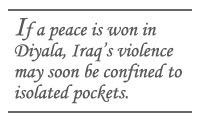
Although, bombers still slip through, the conflict is now mainly fought in Diyala province north of Baghdad, one of Iraq’s smallest with just 1.2 million people. The geography is significant. To the north is territory controlled by Iraq’s Kurdish community, which suffered under Saddam Hussein and would ruthlessly deny the insurgents safe haven; to the east is Shia Iran; to the west are Sunni areas that now support American plans for peace; and to the south is Baghdad that they have mostly lost.
The battle for Diyala may be pivotal to the future of Iraq. Any substantive spread from there could boost morale of border-line insurgents. But if a peace is won in Diyala, Iraq’s violence may soon be confined to isolated pockets.
The electorally created parliamentary and government institutions are not restoring Iraq’s stability and remain ineffective for much of the country. Most Sunnis still regard the government as Shia-led and sectarian, and parliament often fails to sit because not enough members turn up. Crucial legislation such as devolving power to the provinces and sharing oil revenue is log-jammed by parliamentary inactivity.
Real reconciliation is being carried out village by village, district by district, militia by militia, among time-honored local institutions and by leaders no more or less authoritarian than Saddam.
Long-term control of Iraq depends on how effective the central government can prove itself to be in delivering to the electorate. At present, it’s failing.
But there has been substantive grass-roots and private-sector progress. Baghdad real-estate agents estimate that property prices have risen by up to 12 percent since violence dropped. The Iraq Stock Exchange rose 36 percent last year. A private banker says he now has 50,000 clients – compared to just 4,000 when Saddam was in power. He pushes internet banking so customers do not have to risk bomb explosions by visiting branches, and he’s drawn up a plan to install ATM machines throughout the country. The Meshmesha chain, apricot fresh-fruit juice bars in the central suburb of Karrada, has four outlets so far and plans to expand countrywide.
Iraq’s future remains too finely balanced to call, but the talk of partition and civil war once echoing through Washington and Baghdad has diminished. Progress has come, not through Washington’s beltway-sponsored model institutions, but by coaxing existing time-honored ones, whether a grass-roots village committee or the Iranian government – however distasteful some might seem.
Much of the credit belongs to the formidable military-diplomatic partnership of General David Petraeus and Ambassador Crocker. Far from the ideological school sent in directly after the invasion, both men are career professionals who have sought pragmatic common ground within Iraqi society.
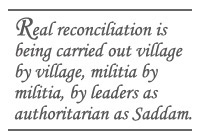
Republican presidential candidate John McCain said “it would be fine with me” for US troops to stay in Iraq for 100 years – as long as they weren’t getting killed and Al Qaeda was still on the loose. Few wars have clean endings. After the Second World War, US troops have remained in Europe. The Korean War is still unfinished, with thousands of troops based in South Korea.
The presidential election debate about Iraq, therefore, may face a substantive change of direction. Six months ago, the Vietnam-style talk was about getting out of a disastrous war. The next six months might focus on a dignified drawdown over many years, and, if Al Qaeda is beaten there, election rhetoric might even echo with thoughts of victory.
Humphrey Hawksley, author of “The History Book,” is a BBC correspondent.